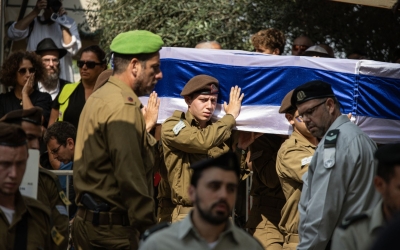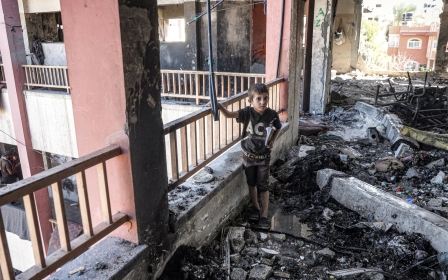Israel’s rising losses in Lebanon and Gaza are proof that this war is unwinnable

There is a simple reason for the renewed interest in ceasefire plans for Gaza and south Lebanon, and the nightly slaughter of Palestinian refugees that accompanies each push for peace.
It has nothing to do with Israel’s assassination campaign of Hamas and Hezbollah leaders or its latest attempt to limit the production of solid rocket fuel in Iran.
Abundant supplies of self-delusion and spin surround the current perception in Israel and Washington that each resistance group is "bruised and battered" and that Iran’s wings have been clipped.
The reason stares the Israeli army’s high command in the face: October has become the bloodiest month for its forces since December last year. Its forces are regularly taking losses in both north Gaza and southern Lebanon.
At the latest count, and these figures change every day, in one month, 62 soldiers have been killed in combat, and 15 civilians and two policemen have been killed in missile strikes and attacks inside Israel.
New MEE newsletter: Jerusalem Dispatch
Sign up to get the latest insights and analysis on Israel-Palestine, alongside Turkey Unpacked and other MEE newsletters
To date, the Israeli army’s rehabilitation department is dealing with more than 12,000 injured soldiers, a toll going up by about 1,000 a month. Many believe this figure is an underestimate of the real number of injuries that have been treated in hospitals.
This includes the opposition figure, Yair Lapid. He told Channel 12: "There are limits to how much we accept the alternative facts."
According to a recent Hezbollah statement, since 1 October, the Lebanese resistance movement killed 90 Israeli soldiers and officers, wounded 750 and destroyed 38 Merkava tanks.
Frequent retreats
At the very least, the Israel military’s campaign to clear north Gaza and south Lebanon of fighters and civilians is meeting fierce resistance and producing, one year on, some of the heaviest fighting in the war.
Any notion that Hamas and Hezbollah have lost their ability to fight since the assassination of their political and military leaders has been brutally discarded.
Follow Middle East Eye's live coverage for all the latest on the Israel-Palestine war
In north Gaza, the Jabalia refugee camp has not been cleared of Hamas fighters, nor has the population of Jabalia and Beit Hanoun been starved into submission and moved south, as prescribed by the "Generals' Plan".
According to the army’s own figures, between 12 and 29 people passed through the Netzarim corridor over three days last week. The movement of population in North Gaza has been westwards towards Gaza City in the north, not north to south, as the army would have wished.
According to the most recent estimates by the UN and its partners, since Israel began its latest offensive on 5 October, more than 71,000 people have been displaced from North Gaza governorate to Gaza City and about 100,000 people remain in North Gaza.
In southern Lebanon, the Israeli army is faring even worse. Three weeks after their invasion, they have not been able to hold ground more than two kilometres from the border and have had to stage frequent retreats when the casualties have become too high.
This is far from their stated goal of pushing Hezbollah back to the Litani river.
Instead, fighters retreat, drawing the Israeli forces into a trap, entering the tunnels and attacking them from the rear.
A source close to Hezbollah told Middle East Eye that the assassination of their senior leadership had had little to no effect on their operational fighting capacity.
He said units are maintaining communication and operational coordination independently, without needing direct orders from central command.
Although both sides in this conflict maximise their gains and minimise their losses, I can believe that.
Latest Israeli offer
On top of the military casualties, 15 civilians and two policemen have also been killed in Israel this month. Hezbollah and the Houthis show no sign of being prevented from sending hundreds of thousands of Israelis to their shelters with their rockets, and Hezbollah too issues its own evacuation orders.
Al Akbar, a media outlet close to Hezbollah circles, quoted one of its sources saying: "Israel is not in a position of strength that allows it to impose conditions as long as the battle continues and the resistance’s situation on the ground is very good."
Which brings us to the real point: how is it that Prime Minister Benjamin Netanyahu thinks that, a year on, he is in a position to dictate terms to Palestinians and the Lebanese?
How is it that Netanyahu thinks that, a year on, he is in a position to dictate terms to Palestinians and the Lebanese?
A meeting in Qatar between the mediators produced a new proposal that was conveyed to Hamas. Since all the sources for this are Israeli, we can assume this latest offer was Israeli.
The offer states that Israel would enable a 30-day ceasefire and the release of an unspecified number of prisoners, in exchange for between 11 and 14 hostages, including women and the elderly, in the first phase, while negotiations on a second phase would continue, but there would be no withdrawal of forces from the Netzarim corridor or Rafah.
This would be coupled or "strengthened" by a US-led ceasefire in Lebanon. Again, the main source for this is the Israeli media, and Channel 12 in particular.
The "deal" being offered to Hezbollah is a ceasefire for 60 days in which the full agreement will be negotiated.
However, during this period, Israel retains "the right to respond to any breach or attack from anywhere". The full agreement Israel has in mind is Hezbollah pulling its forces back to the Litani river, with the Lebanese army taking control of the border area.
Hezbollah had absolutely no hesitation in dismissing this "offer" before it had even been made by the US envoy, Amos Hochstein.
Its media speculated that either Israel was raising the ceiling of its conditions to the maximum, after Hezbollah had regained the military initiative on the ground, or that it had no intention of stopping the war and was leaking details of the plan being hatched by Hochstein in order to torpedo it.
Hamas officially had the same reaction to their “offer”, my sources tell me.
Both organisations are staying true to their negotiating positions with or without their old leaders.
Those are that there will be no ceasefire and prisoner exchange until Israel withdraws its troops from Gaza. And Hezbollah will not stop fighting, let alone consider retreating from the border area, until there is a truce in Gaza.
Both organisations think that Netanyahu is not serious about stopping the war.
Overwhelming delusion
Haaretz’s Amos Harel reports that there is now a consensus in the Israeli defence establishment that the war in Lebanon and Gaza has exhausted itself, and that if it continues, they can not achieve much more than what has already been accomplished.
They, too, think that a prolonged stay in either territory increases the risk of large troop losses.
Agreements should be reached for a ceasefire and release of all hostages still held in Gaza, they conclude.
This is a far cry from any of Israel’s war objectives, which were the destruction of Hamas as a military or governing authority, the creation of demilitarised no-man’s land in north Gaza and southern Lebanon, and a substantial exodus of Palestinians to Egypt and abroad - which Netanyahu tasked his adviser Ron Dermer to plan, as early as last December.
The intensity of the damage in Gaza and Lebanon has persuaded Hamas and Hezbollah that their people have suffered so much since 7 October, that there is no way back
In suing for a ceasefire, defence chiefs in Israel acknowledge that Israel would have to make painful concessions.
Although they are more pragmatic than the war cabinet led by Netanyahu, they too are under an overwhelming delusion.
That, in Harel’s words, “the intensity of the damage inflicted on Hezbollah and Hamas, and recently Iran as well, creates a reasonable opportunity to reach a settlement”.
The opposite is the case.
The intensity of the damage in Gaza and Lebanon has persuaded Hamas and Hezbollah that their people have suffered so much since 7 October, that there is no way back.
This does not mean they are not prepared to negotiate a ceasefire. But it does mean they are in no mood to make substantive concessions.
Parallels from history
There are two parallels from history which should enlighten Israeli leaders who still remain optimistic. The first comes from Palestinian history.
Of the many massacres Palestinians have suffered at the hands of Israeli terror groups - and I include its current army - three stand out.
Seventy-six years ago, there was a massacre in the village of al-Dawayima, in which hundreds were killed, according to the historian Benny Morris.
Sixty-eighty years ago, 47 Palestinians who returned from working in the fields in Kafr Qasim were shot dead for allegedly breaking the curfew; and this week, at least 93 Palestinians were killed in their homes in Beit Lahia where hundreds of displaced people were sheltering.
It is safe to say such suffering has fuelled the Palestinian quest for their own state. None of them stopped the struggle for the liberation of their own land.
Even more pertinent is the experience of the French army in Algeria. The revolution started on 1 November 1954, 70 years ago on Friday, which was All Saints Day or La Toussaint. It became known as Toussaint Rouge.
Exactly a year after that, the rebels launched an attack which killed 120 French soldiers.
The French replied savagely with a campaign that cost 12,000 lives. The brutality of their response alienated opinion in metropolitan France and world opinion - both of which led years later to a complete French withdrawal - not before hundreds of thousands died at the hands of the French.
The Israeli defence chiefs are making the same mistake as their French colonial predecessors did in Algeria. Both think that overwhelming retribution will crush the resistance.
No going back to 6 October
As they congratulate themselves on their "dizzying success" in assassinations and murderous bombing, Israeli defence chiefs should ask themselves whether today they feel as secure as they felt on 6 October 2023, the day before the Hamas attack, or as insecure as they felt on 8 October?
They have not bought themselves security, let alone deterrence. All they have achieved is a series of war crimes, the consequences of which will reverberate for them long after this war is over.
The ultimate weakness of the project to impose a single Jewish state from the river to sea lies in geography as well as demography
But ultimately, the Israeli defence establishment is right to conclude now that the longer the war goes on, the worse it will get for them. There are two imbalances at work here.
Israel’s military advantage over its enemies is enormous. Its reach is regional. It can bomb homes all over the Arab and Iranian world at will.
But the Israeli ability to withstand the consequences of what it is doing, and to suffer pain for it, is far less than the Palestinian ability to pick itself up from one massacre after another, to carry on from generation after generation and still not surrender.
The ultimate weakness of the project to impose a single Jewish state from the river to sea lies in geography as well as demography. This experiment is not happening in some remote part of the world.
It is taking place in the heart of the Muslim and Arab world, and as such, it cannot succeed. Peace can not be reconstructed by rearranging the cells in which Palestinians, the majority of the population, are imprisoned.
It may take many more months of war to realise that there is no going back to 6 October.
The views expressed in this article belong to the author and do not necessarily reflect the editorial policy of Middle East Eye.
Middle East Eye delivers independent and unrivalled coverage and analysis of the Middle East, North Africa and beyond. To learn more about republishing this content and the associated fees, please fill out this form. More about MEE can be found here.







